
- The Contents
- The Making of
- Where Are They Now
- Frequently Asked Questions
- Q & A with Ed Stone

golden record
Where are they now.
- frequently asked questions
- Q&A with Ed Stone
Mission Overview
The twin Voyager 1 and 2 spacecraft are exploring where nothing from Earth has flown before. Continuing on their more-than-40-year journey since their 1977 launches, they each are much farther away from Earth and the sun than Pluto. In August 2012, Voyager 1 made the historic entry into interstellar space, the region between stars, filled with material ejected by the death of nearby stars millions of years ago. Voyager 2 entered interstellar space on November 5, 2018 and scientists hope to learn more about this region. Both spacecraft are still sending scientific information about their surroundings through the Deep Space Network, or DSN.
The primary mission was the exploration of Jupiter and Saturn. After making a string of discoveries there — such as active volcanoes on Jupiter's moon Io and intricacies of Saturn's rings — the mission was extended. Voyager 2 went on to explore Uranus and Neptune, and is still the only spacecraft to have visited those outer planets. The adventurers' current mission, the Voyager Interstellar Mission (VIM), will explore the outermost edge of the Sun's domain. And beyond.
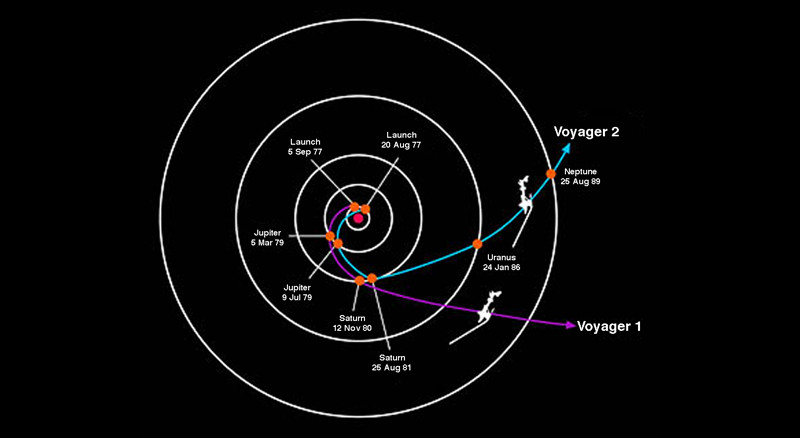
Interstellar Mission
The mission objective of the Voyager Interstellar Mission (VIM) is to extend the NASA exploration of the solar system beyond the neighborhood of the outer planets to the outer limits of the Sun's sphere of influence, and possibly beyond.
› Learn more
Planetary Voyage
The twin spacecraft Voyager 1 and Voyager 2 were launched by NASA in separate months in the summer of 1977 from Cape Canaveral, Florida. As originally designed, the Voyagers were to conduct closeup studies of Jupiter and Saturn, Saturn's rings, and the larger moons of the two planets.
› View more

Launch: Voyager 2 launched on August 20, 1977, from Cape Canaveral, Florida aboard a Titan-Centaur rocket. On September 5, Voyager 1 launched, also from Cape Canaveral aboard a Titan-Centaur rocket.

Suggested Searches
- Climate Change
- Expedition 64
- Mars perseverance
- SpaceX Crew-2
- International Space Station
- View All Topics A-Z
Humans in Space
Earth & climate, the solar system, the universe, aeronautics, learning resources, news & events.

NASA’s Commercial Partners Deliver Cargo, Crew for Station Science

Hi-C Rocket Experiment Achieves Never-Before-Seen Look at Solar Flares

NASA Is Helping Protect Tigers, Jaguars, and Elephants. Here’s How.
- Search All NASA Missions
- A to Z List of Missions
- Upcoming Launches and Landings
- Spaceships and Rockets
- Communicating with Missions
- James Webb Space Telescope
- Hubble Space Telescope
- Why Go to Space
- Astronauts Home
- Commercial Space
- Destinations
- Living in Space
- Explore Earth Science
- Earth, Our Planet
- Earth Science in Action
- Earth Multimedia
- Earth Science Researchers
- Pluto & Dwarf Planets
- Asteroids, Comets & Meteors
- The Kuiper Belt
- The Oort Cloud
- Skywatching
- The Search for Life in the Universe
- Black Holes
- The Big Bang
- Dark Energy & Dark Matter
- Earth Science
- Planetary Science
- Astrophysics & Space Science
- The Sun & Heliophysics
- Biological & Physical Sciences
- Lunar Science
- Citizen Science
- Astromaterials
- Aeronautics Research
- Human Space Travel Research
- Science in the Air
- NASA Aircraft
- Flight Innovation
- Supersonic Flight
- Air Traffic Solutions
- Green Aviation Tech
- Drones & You
- Technology Transfer & Spinoffs
- Space Travel Technology
- Technology Living in Space
- Manufacturing and Materials
- Science Instruments
- For Kids and Students
- For Educators
- For Colleges and Universities
- For Professionals
- Science for Everyone
- Requests for Exhibits, Artifacts, or Speakers
- STEM Engagement at NASA
- NASA's Impacts
- Centers and Facilities
- Directorates
- Organizations
- People of NASA
- Internships
- Our History
- Doing Business with NASA
- Get Involved
- Aeronáutica
- Ciencias Terrestres
- Sistema Solar
- All NASA News
- Video Series on NASA+
- Newsletters
- Social Media
- Media Resources
- Upcoming Launches & Landings
- Virtual Events
- Sounds and Ringtones
- Interactives
- STEM Multimedia

C.26 Rapid Mission Design Studies for Mars Sample Return Correction and Other Documents Posted
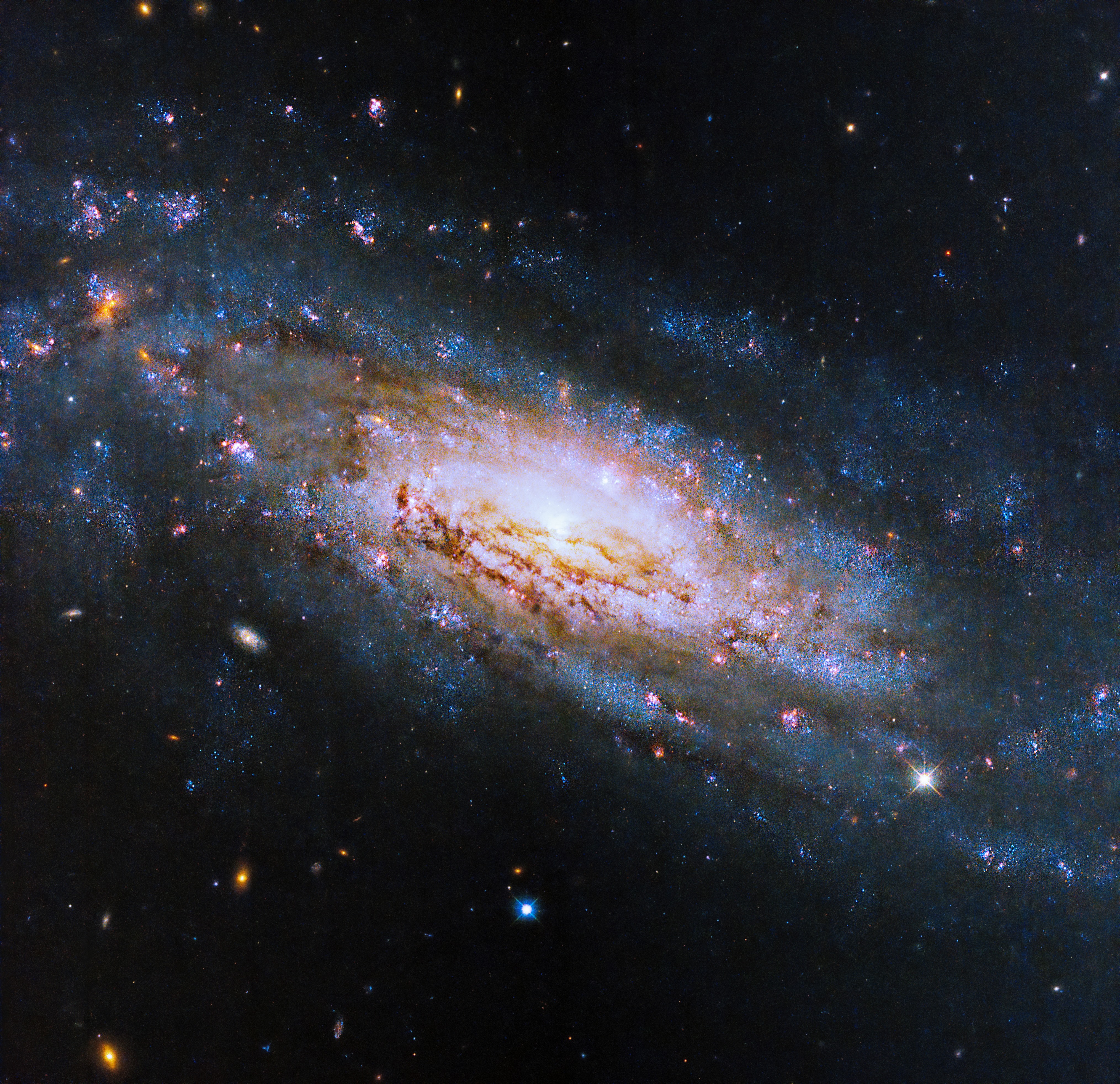
Hubble Views a Galaxy with a Voracious Black Hole

Hubble Hunts Visible Light Sources of X-Rays

NASA Mission Strengthens 40-Year Friendship

NASA Selects Commercial Service Studies to Enable Mars Robotic Science

Two Small NASA Satellites Will Measure Soil Moisture, Volcanic Gases

NASA-Led Study Provides New Global Accounting of Earth’s Rivers

NASA Selects Students for Europa Clipper Intern Program

Orbits and Kepler’s Laws

New NASA Black Hole Visualization Takes Viewers Beyond the Brink

Black Hole Week

The Big Event, 2024

ARMD Solicitations

NASA’s Commitment to Safety Starts with its Culture

NASA Uses Small Engine to Enhance Sustainable Jet Research

Tech Today: NASA’s Ion Thruster Knowhow Keeps Satellites Flying

Big Science Drives Wallops’ Upgrades for NASA Suborbital Missions

NASA Community College Aerospace Scholars

NASA Grant Brings Students at Underserved Institutions to the Stars

Asian-American and Native Hawaiian Pacific Islander Heritage Month

Diez maneras en que los estudiantes pueden prepararse para ser astronautas

Astronauta de la NASA Marcos Berríos

Resultados científicos revolucionarios en la estación espacial de 2023
The voyage to interstellar space.
Susannah Darling

Katy Mersmann
The magnetometer, the cosmic ray subsystem, the plasma instrument.
By all means, Voyager 1 and Voyager 2 shouldn’t even be here. Now in interstellar space, they are pushing the limits of spacecraft and exploration, journeying through the cosmic neighborhood, giving us our first direct look into the space beyond our star.
But when they launched in 1977, Voyager 1 and Voyager 2 had a different mission: to explore the outer solar system and gather observations directly at the source, from outer planets we had only seen with remote studies. But now, four decades after launch, they’ve journeyed farther than any other spacecraft from Earth; into the cold, quiet world of interstellar space.
Originally designed to measure the properties of the giant planets, the instruments on both spacecraft have spent the past few decades painting a picture of the propagation of solar events from our Sun. And the Voyagers’ new mission focuses not only on effects on space from within our heliosphere — the giant bubble around the Sun filled up by the constant outflow of solar particles called the solar wind — but from outside of it. Though they once helped us look closer at the planets and their relationship to the Sun, they now give us clues about the nature of interstellar space as the spacecraft continue their journey.
The environment they explore is colder, subtler and more tenuous than ever before, and yet the Voyagers continue on, exploring and measuring the interstellar medium, a smorgasbord of gas, plasma and particles from stars and gas regions not originating from our system. Three of the spacecraft’s 10 instruments are the major players that study how space inside the heliosphere differs from interstellar space. Looking at this data together allows scientist to piece together our best-yet picture of the edge of the heliosphere and the interstellar medium. Here are the stories they tell.
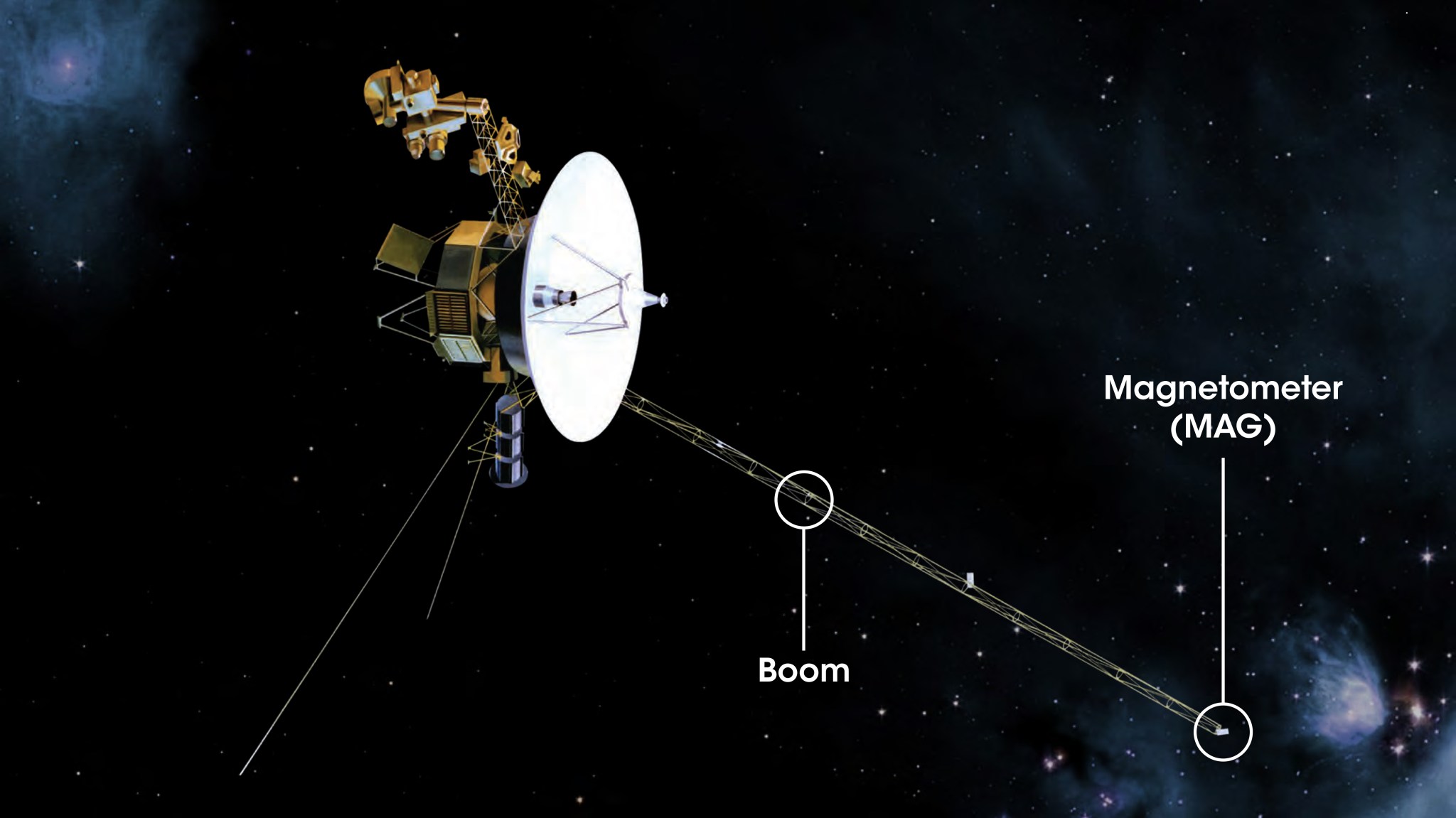
On the Sun Spot , we have been exploring the various instruments on Voyager 2 one at a time, and analyzing how scientists read the individual sets of data sent to Earth from the far-reaching spacecraft. But one instrument we have not yet talked about is Voyager 2’s Magnetometer, or MAG for short.
During the Voyagers’ first planetary mission, the MAG was designed to investigate the magnetospheres of planets and their moons, determining the physical mechanics and processes of the interactions of those magnetic fields and the solar wind. After that mission ended, the Voyager spacecraft studied the magnetic field of the heliosphere and beyond, observing the magnetic reach of the Sun and the changes that occur within that reach during solar activity.
Getting the magnetic data as we travel further into space requires an interesting trick. Voyager spins itself around, in a calibration maneuver that allows Voyager to differentiate between the spacecraft’s own magnetic field — that goes along for the ride as it spins — and the magnetic fields of the space it’s traveling through.
The initial peek into the magnetic field beyond the Sun’s influence happened when Voyager 1 crossed the heliopause in 2012. Scientists saw that within the heliosphere, the strength of the magnetic field was quite variable, changing and jumping as Voyager 1 moved through the heliosphere. These changes are due to solar activity. But once Voyager 1 crossed into interstellar space, that variability was silenced. Although the strength of the field was similar to what it was inside the heliosphere, it no longer had the variability associated with the Sun’s outbursts.
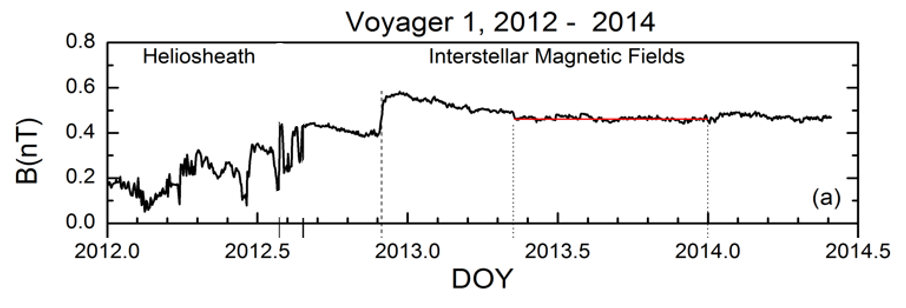
This graph shows the magnitude, or the strength, of the magnetic field around the heliopause from January 2012 out to May 2014. Before encountering the heliopause, marked by the orange line, the magnetic strength fluctuates quite a bit. After a bumpy ride through the heliopause in 2012, the magnetic strength stops fluctuating and begins to stabilize in 2013, once the spacecraft is far enough out into the interstellar medium.
In November 2018, Voyager 2 also crossed the heliopause and similarly experienced quite the bumpy ride out of the heliopause. Scientists are excited to see how its journey differs from its twin spacecraft.
Scientists are still working through the MAG data from Voyager 2, and are excited to see how Voyager 2’s journey differed from Voyager 1.
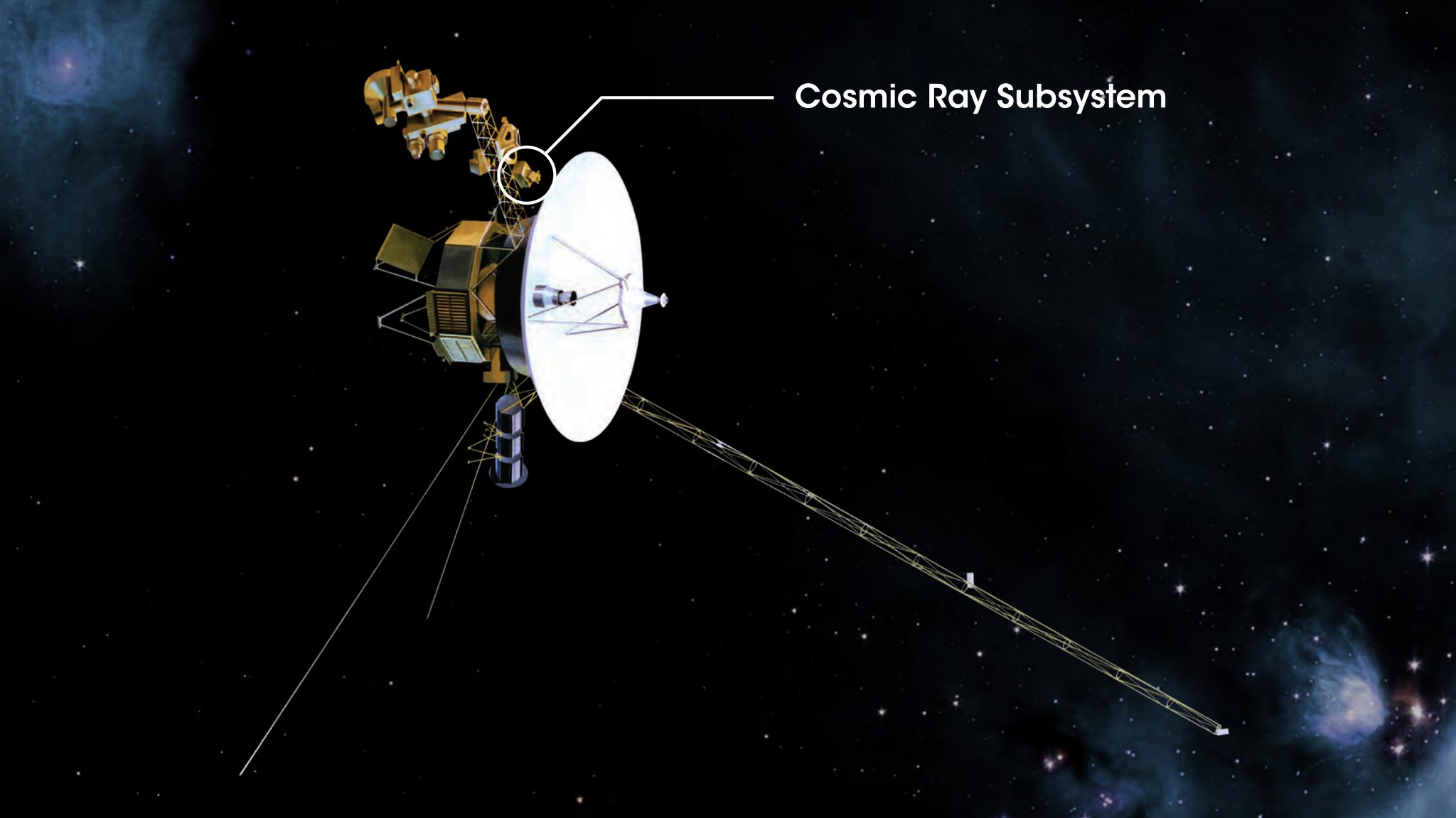
Much like the MAG, the Cosmic Ray Subsystem — called CRS — was originally designed to measure planetary systems. The CRS focused on the compositions of energetic particles in the magnetospheres of Jupiter, Saturn, Uranus and Neptune. Scientists used it to study the charged particles within the solar system and their distribution between the planets. Since it passed the planets, however, the CRS has been studying the heliosphere’s charged particles and — now — the particles in the interstellar medium.
The CRS measures the count rate, or how many particles detected per second. It does this by using two telescopes: the High Energy Telescope, which measures high energy particles (70MeV) identifiable as interstellar particles, and the Low Energy Telescope, which measures low-energy particles (5MeV) that originate from our Sun. You can think of these particles like a bowling ball hitting a bowling pin versus a bullet hitting the same pin — both will make a measurable impact on the detector, but they’re moving at vastly different speeds. By measuring the amounts of the two kinds of particles, Voyager can provide a sense of the space environment it’s traveling through.
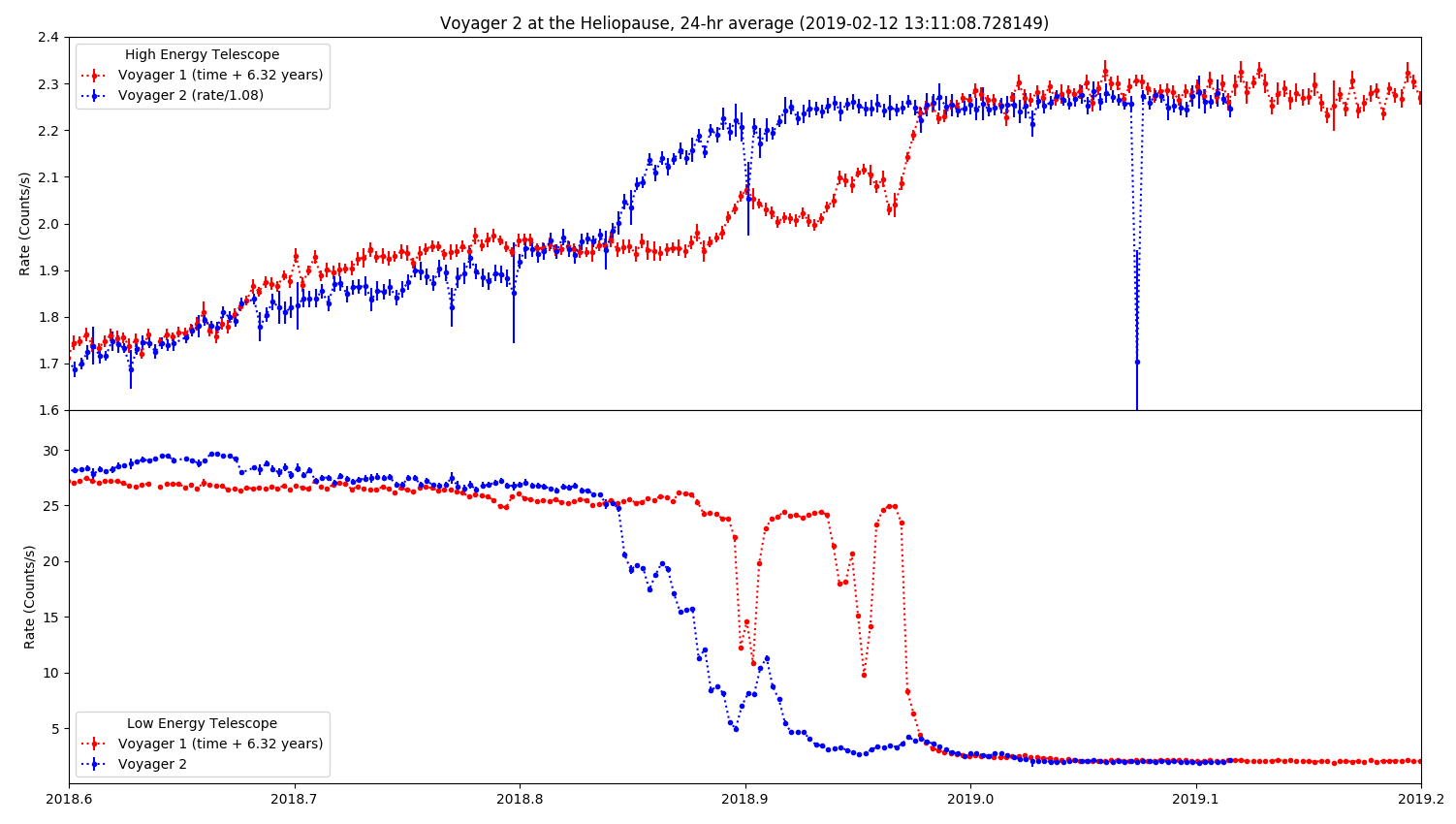
These graphs show the count rate — how many particles per second are interacting with the CRS on average each day — of the galactic ray particles measured by the High Energy Telescope (top graph) and the heliospheric particles measured by the Low Energy Telescope (bottom graph). The line in red shows the data from Voyager 1, time shifted forward 6.32 years from 2012 to match up with the data from Voyager around November 2018, shown in blue.
CRS data from Voyager 2 on Nov. 5, 2018, showed the interstellar particle count rate of the High Energy Telescope increasing to count rates similar to what Voyager 1 saw then leveling out. Similarly, the Low Energy Telescope shows a severe decrease in heliospheric originating particles. This was a key indication that Voyager 2 had moved into interstellar space. Scientists can keep watching these counts to see if the composition of interstellar space particles changes along the journey.
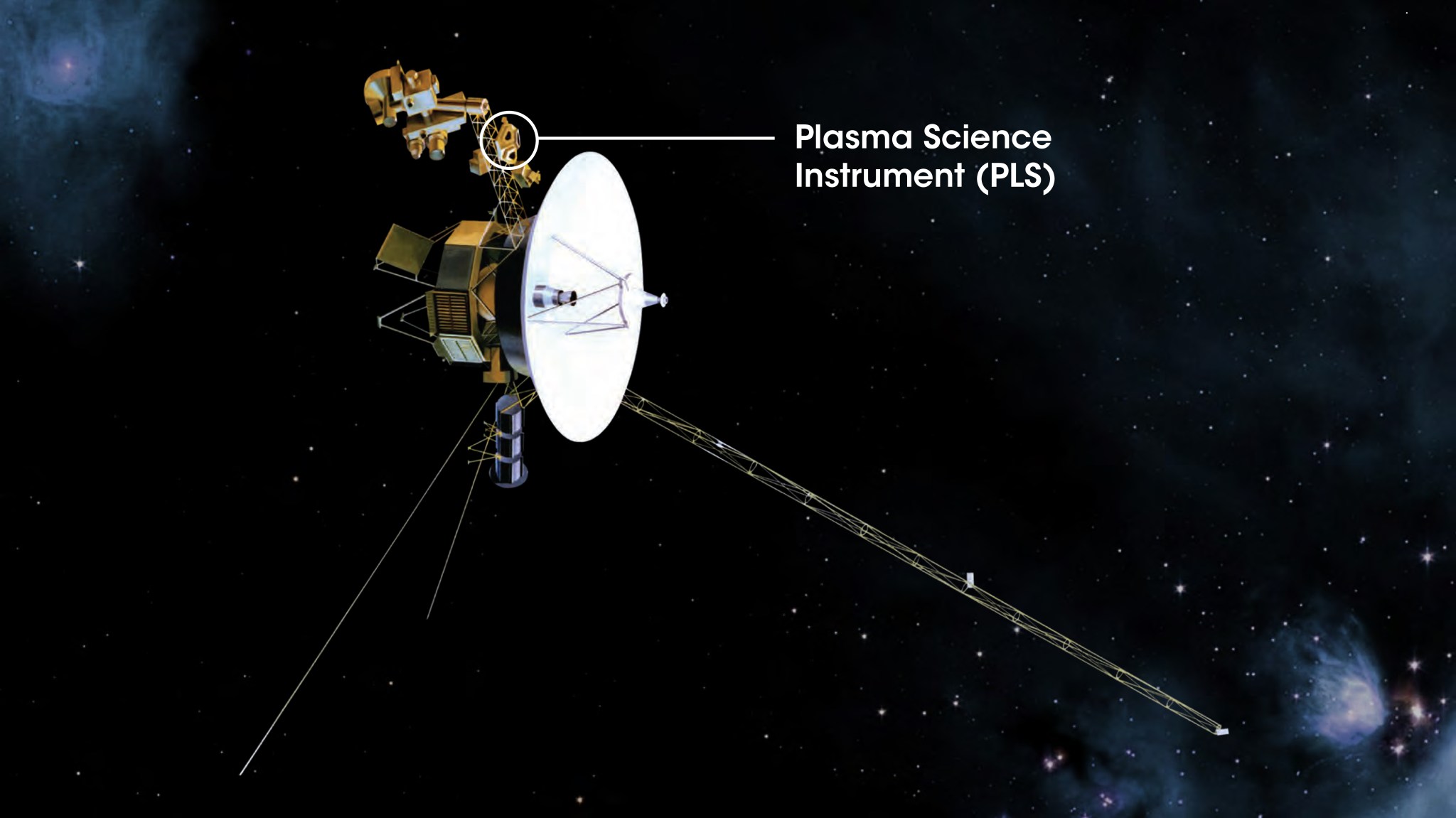
The Plasma Science instrument, or PLS, was made to measure plasma and ionized particles around the outer planets and to measure the solar wind’s influence on those planets. The PLS is made up of four Faraday cups, an instrument that measures the plasma as it passes through the cups and calculates the plasma’s speed, direction and density.
The plasma instrument on Voyager 1 was damaged during a fly-by of Saturn and had to be shut off long before Voyager 1 exited the heliosphere, making it unable to measure the interstellar medium’s plasma properties. With Voyager 2’s crossing, scientists will get the first-ever plasma measurements of the interstellar medium.
Scientists predicted that interstellar plasma measured by Voyager 2 would be higher in density but lower in temperature and speed than plasma inside the heliosphere. And in November 2018, the instrument saw just that for the first time. This suggests that the plasma in this region is getting colder and slower, and, like cars slowing down on a freeway, is beginning to pile up around the heliopause and into the interstellar medium.
And now, thanks to Voyager 2’s PLS, we have a never-before-seen perspective on our heliosphere: The plasma velocity from Earth to the heliopause.
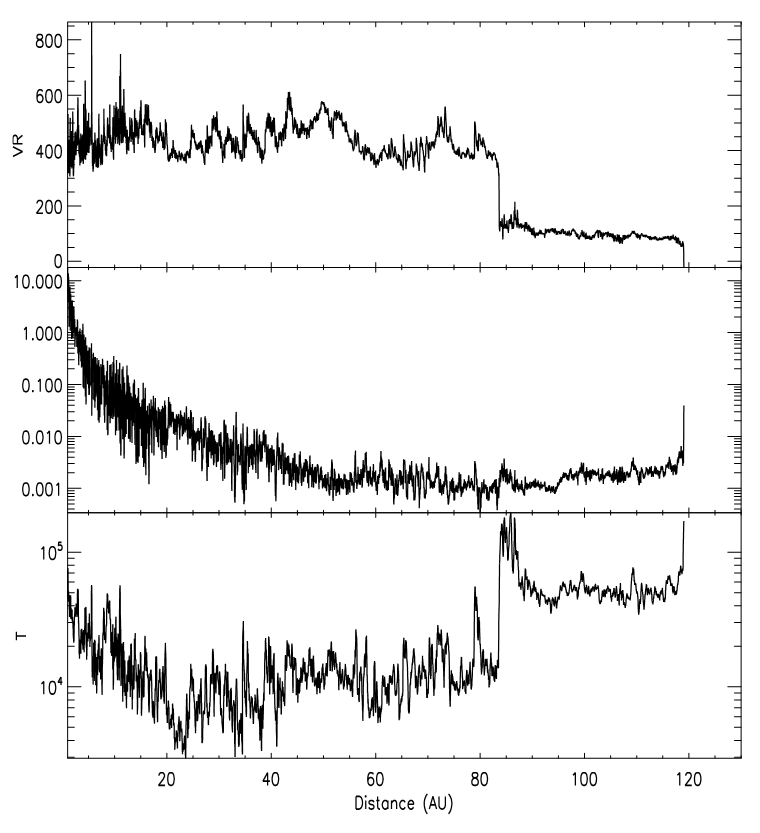
These three graphs tell an amazing story, summarizing a journey of 42 years in one plot. The top section of this graph shows the plasma velocity, how fast the plasma across the heliosphere is moving, against the distance out from Earth. The distance is in astronomical units; one astronomical unit is the average distance between the Sun and Earth, about 93 million miles. For context, Saturn is 10 AU from Earth, while Pluto is about 40 AU away.
The heliopause crossing happened at 120 AU, when the velocity of plasma coming out from the Sun drops to zero (seen on the top graph), and the outward flow of the plasma is diverted — seen in the increase in the two bottom graphs, which show the upwards and downward speeds (the normal velocity, middle graph) and the sideways speed of the solar wind (the tangential velocity, bottom graph) of the solar wind plasma, respectively. This means as the solar wind begins to interact with the interstellar medium, it is pushed out and away, like a wave hitting the side of a cliff.
Looking at each instrument in isolation, however, does not tell the full story of what interstellar space at the heliopause looks like. Together, these instruments tell a story of the transition from the turbulent, active space within our Sun’s influence to the relatively calm waters on the edge of interstellar space.
The MAG shows that the magnetic field strength decreases sharply in the interstellar medium. The CRS data shows an increase in interstellar cosmic rays, and a decrease in heliospheric particles. And finally, the PLS shows that there’s no longer any detectable solar wind.
Now that the Voyagers are outside of the heliosphere, their new perspective will provide new information about the formation and state of our Sun and how it interacts with interstellar space, along with insight into how other stars interact with the interstellar medium.
Voyager 1 and Voyager 2 are providing our first look at the space we would have to pass through if humanity ever were to travel beyond our home star — a glimpse of our neighborhood in space.
Related links:
- Video: “NASA Science Live: Going Interstellar”
- Explore Voyager 2 data on “The Sun Spot” blog
By Susannah Darling NASA’s Goddard Space Flight Center , Greenbelt, Md.

Interstellar Mission
Voyager 1 reached interstellar space in August 2012 and is the most distant human-made object in existence.

Mission Statistics
Launch Date
Sept. 5, 1977
About the mission
Voyager 1 reached interstellar space in August 2012 and is the most distant human-made object in existence. Launched just shortly after its twin spacecraft, Voyager 2, in 1977, Voyager 1 explored the Jovian and Saturnian systems discovering new moons, active volcanoes and a wealth of data about the outer solar system.
Voyagers 1 and 2 were designed to take advantage of a rare planetary alignment that occurs only once in 176 years and remain the most well traveled spacecraft in history. Both spacecraft carry a sort of time capsule called the Golden Record, a 12-inch gold-plated copper disk containing sounds and images selected to portray the story of our world to extraterrestrials.
Instruments
- Imaging system
- Infrared interferometer spectrometer
- Ultraviolet spectrometer
- Triaxial fluxgate magnetometer
- Plasma spectrometer
- Low-energy charged particles detectors
- Cosmic Ray System (CRS)
- Photopolarimeter System (PPS)
- Plasma Wave System (PWS)
Mission Highlights
Sept. 1, 2013

Interactive 3D model of Voyager 1. View the full interactive experience at Eyes on the Solar System .
More From Forbes
Nasa’s new ‘voyager’: 7 things to know about the 50-year ‘interstellar probe’ mission to burst our cosmic bubble.
- Share to Facebook
- Share to Twitter
- Share to Linkedin
Scientists hope the proposed Interstellar Probe will teach us more about our home in the galaxy as ... [+] well as how other stars in the galaxy interact with their interstellar neighbourhoods.
On February 14, 1990, NASA’s Voyager 1 space probe turned its cameras back towards the Sun and took a hazy, fuzzy and not particularly useful image that included our planet as a “a mote of dust suspended in a sunbeam.”
The late popular astronomer Carl Sagan, who wrote those words about the now iconic “Pale Blue Dot” photo (below) would today surely be working on the “Interstellar Probe,” a new mission concept to boldly go where no spacecraft has gone before.
Being discussed this week at the European Geoscience Union General Assembly 2021, scientists are planning for the Interstellar Probe to reach the “interstellar medium”—the space beyond our Solar System—that’s about 10 times as far as the Voyager spacecraft have gone.
In doing so it will find out the nature of the “cosmic bubble” that envelopes the Sun, in which the Solar System exists, but it could also uncover a few new worlds on its way.
Here are seven things you need to know about this groundbreaking 50-year mission:
This image of Earth is one of 60 frames taken by the Voyager 1 spacecraft on February 14, 1990 from ... [+] a distance of more than 6 billion kilometers (4 billion miles) and about 32 degrees above the ecliptic plane. In the image the Earth is a mere point of light, a crescent only 0.12 pixel in size. Our planet was caught in the center of one of the scattered light rays resulting from taking the image so close to the Sun. This image is part of Voyager 1's final photographic assignment which captured family portraits of the Sun and planets.
Apple iPhone 16 New Design And Performance Upgrades Revealed In Leak
Google s aggressive new pixel 8 discounts are not ending, samsung releases new feature boost to millions of galaxy phones, 1. it will update our ‘pale blue dot’ photo.
“The Interstellar Probe will go to the unknown local interstellar space, where humanity has never reached before,” said Elena Provornikova, the Interstellar Probe heliophysics lead from the Johns Hopkins Applied Physics Lab (APL) in Maryland.
“For the first time, we will take a picture of our vast heliosphere from the outside to see what our Solar System home looks like.”
2. It would be our boldest move since the Moon landings
That’s according to the scientists behind the concept, who say that this first deliberate step into the sea of space between our Sun and other potentially habitable systems would lead to new and inspiring exploration.
The project is being led by the Johns Hopkins University Applied Physics Laboratory (APL), but the concept study now underway is being funded by NASA. It’s largely based on current technology.
An artist concept depicting one of NASA's twin Voyager spacecraft. Humanity's farthest and ... [+] longest-lived spacecraft are celebrating 40 years in August and September 2017.
3. It will go about 10 times as far as the Voyager spacecraft
Voyager 1 and Voyager 2 spacecraft entered interstellar space in 2012 and 2018, respectively. They’ve traveled about 120 astronomical units (au)—120 times the distance from the Earth to the Sun—and are at the boundary of the heliosphere, the Sun’s sphere of influence.
The Interstellar Probe will reach 1,000 AU and enter the interstellar medium —the space between the stars.
4. It could launch in 2030 and last for over 50 years
Slated to launch in the early 2030s, Interstellar Probe would take about 15 years to reach the heliosphere boundary. That’s super-quick. After all, the two Voyager spacecraft took 35 years to reach the same place. The lifespan of this Interstellar Probe is rated at 50 years, which would give it 35 years—and likely much longer—to explore a totally new region of space.
A key recent innovation that makes this possible is NASA’s SLS heavy-lift rocket, which could get the Interstellar Probe to the velocity necessary—and allow it to cover about seven au per year.
Scientists plan for the Interstellar Probe to reach 1,000 AU — 1 AU is the distance from the sun to ... [+] Earth — into the interstellar medium. That’s about 10 times as far as the Voyager spacecraft have gone.
5. It will explore our ‘shield’ from the outside
The heliosphere is the extent of the Sun’s influence. It’s the limit of the solar wind—that stream of charged particles that the Sun throws out into space—but it also shields our Solar System from high-energy galactic cosmic rays. Science instruments on the Interstellar Probe will find out:
- How the Sun’s plasma interacts with interstellar gas to create our heliosphere.
- What lies beyond the heliosphere
- What our heliosphere even looks like from the outside.
It will use energetic neutral atoms to take images of the heliosphere and could even detect extragalactic background light from the early times of our galaxy’s formation.
6. It could fly-by a dwarf planet we know nothing about
Forget the “eight planets” thing. Sure, Pluto got relegated to dwarf planet status, but the real story was always this: the Solar System has a ton of small planets. Beyond Pluto there are reckoned to be about 130 dwarf planets, but as we know from exploring Pluto (which turned out to be geologically active and may have an underground ocean of liquid water), many are they’re way more geologically complex and interesting than we thought.
So on its way out to deep space the Interstellar Probe could swing by either Quaoar or Gonggong —which could be geologically active—plus another dwarf planet.
Our solar journey through space is carrying us through a cluster of very low density interstellar ... [+] clouds. Right now the Sun is inside of a cloud (Local cloud) that is so tenuous that the interstellar gas detected by IBEX is as sparse as a handful of air stretched over a column that is hundreds of light years long. These clouds are identified by their motions, indicated in this graphic with blue arrows.
7. It will recce the next region of space we’re about to enter
That shield around our Solar System may be about to get swamped. The Sun orbits the center of the Milky Way galaxy about once every 220-250 million years. That’s a galactic year, which makes the Earth about 16 years old. Scientists think that the Sun is currently on the edge of the Local Interstellar Cloud, having spent millions of years traveling through it, and will soon move into a new region of interstellar space.
So the Interstellar Probe will see what’s coming next, and whether the Sun’s heliosphere adjusts to a changing level of galactic cosmic rays in this new region of space. If there are more, it could raise the level of background radiation level at Earth. As a bonus scientists will also discover how out Sun, and by extension, all stars, interacts with the local galaxy.
At the end of 2021 the team will deliver a report to NASA that outlines potential science, example instrument payloads, and example spacecraft and trajectory designs for the mission. “Our approach is to lay out the menu of what can be done in such a space mission,” said Provornikova.
Wishing you clear skies and wide eyes.

- Editorial Standards
- Reprints & Permissions
- Become A Member
- Gift Membership
- Kids Membership
- Other Ways to Give
- Explore Worlds
- Defend Earth
How We Work
- Education & Public Outreach
- Space Policy & Advocacy
- Science & Technology
- Global Collaboration
Our Results
Learn how our members and community are changing the worlds.
Our citizen-funded spacecraft successfully demonstrated solar sailing for CubeSats.

Space Topics
- Planets & Other Worlds
- Space Missions
- Space Policy
- Planetary Radio
- Space Images
The Planetary Report
The eclipse issue.
Science and splendor under the shadow.
Get Involved
Membership programs for explorers of all ages.
Get updates and weekly tools to learn, share, and advocate for space exploration.
Volunteer as a space advocate.
Support Our Mission
- Renew Membership
- Society Projects
The Planetary Fund
Accelerate progress in our three core enterprises — Explore Worlds, Find Life, and Defend Earth. You can support the entire fund, or designate a core enterprise of your choice.
- Strategic Framework
- News & Press
The Planetary Society
Know the cosmos and our place within it.
Our Mission
Empowering the world's citizens to advance space science and exploration.
- Explore Space
- Take Action
- Member Community
- Account Center
- “Exploration is in our nature.” - Carl Sagan
The Voyager missions
Highlights Voyager 1 and Voyager 2 launched in 1977 and made a grand tour of the solar system's outer planets. They are the only functioning spacecraft in interstellar space, and they are still sending back measurements of the interstellar medium. Each spacecraft carries a copy of the golden record, a missive from Earth to any alien lifeforms that may find the probes in the future.
What are the Voyager missions?
The Voyager program consists of two spacecraft: Voyager 1 and Voyager 2. Voyager 2 was actually launched first, in August 1977, but Voyager 1 was sent on a faster trajectory when it launched about two weeks later. They are the only two functioning spacecraft currently in interstellar space, beyond the environment controlled by the sun.
Voyager 2’s path took it past Jupiter in 1979, Saturn in 1981, Uranus in 1985, and Neptune in 1989. It is the only spacecraft to have visited Uranus or Neptune, and has provided much of the information that we use to characterize them now.
Because of its higher speed and more direct trajectory, Voyager 1 overtook Voyager 2 just a few months after they launched. It visited Jupiter in 1979 and Saturn in 1980. It overtook Pioneer 10 — the only other spacecraft in interstellar space thus far — in 1998 and is now the most distant artificial object from Earth.
How the Voyagers work
The two spacecraft are identical, each with a radio dish 3.7 meters (12 feet) across to transmit data back to Earth and a set of 16 thrusters to control their orientations and point their dishes toward Earth. The thrusters run on hydrazine fuel, but the electronic components of each spacecraft are powered by thermoelectric generators that run on plutonium. Each carries 11 scientific instruments, about half of which were designed just for observing planets and have now been shut off. The instruments that are now off include several cameras and spectrometers to examine the planets, as well as two radio-based experiments. Voyager 2 now has five functioning instruments: a magnetometer, a spectrometer designed to investigate plasmas, an instrument to measure low-energy charged particles and one for cosmic rays, and one that measures plasma waves. Voyager 1 only has four of those, as its plasma spectrometer is broken.
Jupiter findings
Over the course of their grand tours of the solar system, the Voyagers took tens of thousands of images and measurements that significantly changed our understanding of the outer planets.
At Jupiter, they gave us our first detailed ideas of how the planet’s atmosphere moves and evolves, showing that the Great Red Spot was a counter-clockwise rotating storm that interacted with other, smaller storms. They were also the first missions to spot a faint, dusty ring around Jupiter. Finally, they observed some of Jupiter’s moons, discovering Io’s volcanism, finding the linear features on Europa that were among the first hints that it might have an ocean beneath its surface, and granting Ganymede the title of largest moon in the solar system, a superlative that was previously thought to belong to Saturn’s moon Titan.
Saturn findings
Next, each spacecraft flew past Saturn, where they measured the composition and structure of Saturn’s atmosphere , and Voyager 1 also peered into Titan’s thick haze. Its observations led to the idea that Titan might have liquid hydrocarbons on its surface, a hypothesis that has since been verified by other missions. When the two missions observed Saturn’s rings, they found the gaps and waves that are well-known today. Voyager 1 also spotted three previously-unknown moons orbiting Saturn: Atlas, Prometheus, and Pandora.
Uranus and Neptune findings
After this, Voyager 1 headed out of the solar system, while Voyager 2 headed toward Uranus . There, it found 11 previously-unknown moons and two previously-unknown rings. Many of the phenomena it observed on Uranus remained unexplained, such as its unusual magnetic field and an unexpected lack of major temperature changes at different latitudes.
Voyager 2’s final stop, 12 years after it left Earth, was Neptune. When it arrived , it continued its streak of finding new moons with another haul of 6 small satellites, as well as finding rings around Neptune. As it did at Uranus, it observed the planet’s composition and magnetic field. It also found volcanic vents on Neptune’s huge moon Triton before it joined Voyager 1 on the way to interstellar space.
Interstellar space
Interstellar space begins at the heliopause, where the solar wind – a flow of charged particles released by the sun – is too weak to continue pushing against the interstellar medium, and the pressure from the two balances out. Voyager 1 officially entered interstellar space in August 2012, and Voyager 2 joined it in November 2018.
These exits were instrumental in enabling astronomers to determine where exactly the edge of interstellar space is, something that’s difficult to measure from within the solar system. They showed that interstellar space begins just over 18 billion kilometers (about 11 billion miles) from the sun. The spacecraft continue to send back data on the structure of the interstellar medium.
After its planetary encounters, Voyager 1 took the iconic “Pale Blue Dot” image , showing Earth from about 6 billion kilometers (3.7 billion miles) away. As of 2021 , Voyager 1 is about 155 astronomical units (14.4 billion miles) from Earth, and Voyager 2 is nearly 129 astronomical units (12 billion miles) away.
The golden records
Each Voyager spacecraft has a golden phonograph record affixed to its side, intended as time capsules from Earth to any extraterrestrial life that might find the probes sometime in the distant future. They are inscribed with a message from Jimmy Carter, the U.S. President at the time of launch, which reads: “This is a present from a small, distant world, a token of our sounds, our science, our images, our music, our thoughts and our feelings. We are attempting to survive our time so we may live into yours.”
The covers of the records have several images inscribed, including visual instructions on how to play them, a map of our solar system’s location with respect to a set of 14 pulsars, and a drawing of a hydrogen atom. They are plated with uranium – its rate of decay will allow any future discoverers of either of the records to calculate when they were created.
The records’ contents were selected by a committee chaired by Carl Sagan. Each contains 115 images, including scientific diagrams of the solar system and its planets, the flora and fauna of Earth, and examples of human culture. There are natural sounds, including breaking surf and birdsong, spoken greetings in 55 languages, an hour of brainwave recordings, and an eclectic selection of music ranging from Beethoven to Chuck Berry to a variety of folk music.
Learn more Voyager Mission Status Bulletin Archives Experience A Message From Earth - Inspired by the Voyager Golden Record Neptune, planet of wind and ice
Support missions like Voyager 1 and 2
Whether it's advocating, teaching, inspiring, or learning, you can do something for space, right now. Let's get to work.
For full functionality of this site it is necessary to enable JavaScript. Here are instructions on how to enable JavaScript in your web browser .

The most distant human-made object

No spacecraft has gone farther than NASA's Voyager 1. Launched in 1977 to fly by Jupiter and Saturn, Voyager 1 crossed into interstellar space in August 2012 and continues to collect data.
Mission Type
What is Voyager 1?
Voyager 1 has been exploring our solar system since 1977. The probe is now in interstellar space, the region outside the heliopause, or the bubble of energetic particles and magnetic fields from the Sun. Voyager 1 was launched after Voyager 2, but because of a faster route, it exited the asteroid belt earlier than its twin, and it overtook Voyager 2 on Dec. 15, 1977.
- Voyager 1 was the first spacecraft to cross the heliosphere, the boundary where the influences outside our solar system are stronger than those from our Sun.
- Voyager 1 is the first human-made object to venture into interstellar space.
- Voyager 1 discovered a thin ring around Jupiter and two new Jovian moons: Thebe and Metis.
- At Saturn, Voyager 1 found five new moons and a new ring called the G-ring.
In Depth: Voyager 1
Voyager 1 at jupiter.
Voyager 1 began its Jovian imaging mission in April 1978 at a range of 165 million miles (265 million km) from the planet. Images sent back by January the following year indicated that Jupiter’s atmosphere was more turbulent than during the Pioneer flybys in 1973–1974.
Beginning on January 30, Voyager 1 took a picture every 96 seconds for a span of 100 hours to generate a color timelapse movie to depict 10 rotations of Jupiter. On Feb. 10, 1979, the spacecraft crossed into the Jovian moon system and by early March, it had already discovered a thin (less than 30 kilometers thick) ring circling Jupiter.
Voyager 1’s closest encounter with Jupiter was at 12:05 UT on March 5, 1979 at a range of about 174,000 miles (280,000 km). It encountered several of Jupiter’s Moons, including Amalthea, Io, Europa, Ganymede, and Callisto, returning spectacular photos of their terrain, opening up completely new worlds for planetary scientists.
The most interesting find was on Io, where images showed a bizarre yellow, orange, and brown world with at least eight active volcanoes spewing material into space, making it one of the most (if not the most) geologically active planetary body in the solar system. The presence of active volcanoes suggested that the sulfur and oxygen in Jovian space may be a result of the volcanic plumes from Io which are rich in sulfur dioxide. The spacecraft also discovered two new moons, Thebe and Metis.
Voyager 1 at Saturn
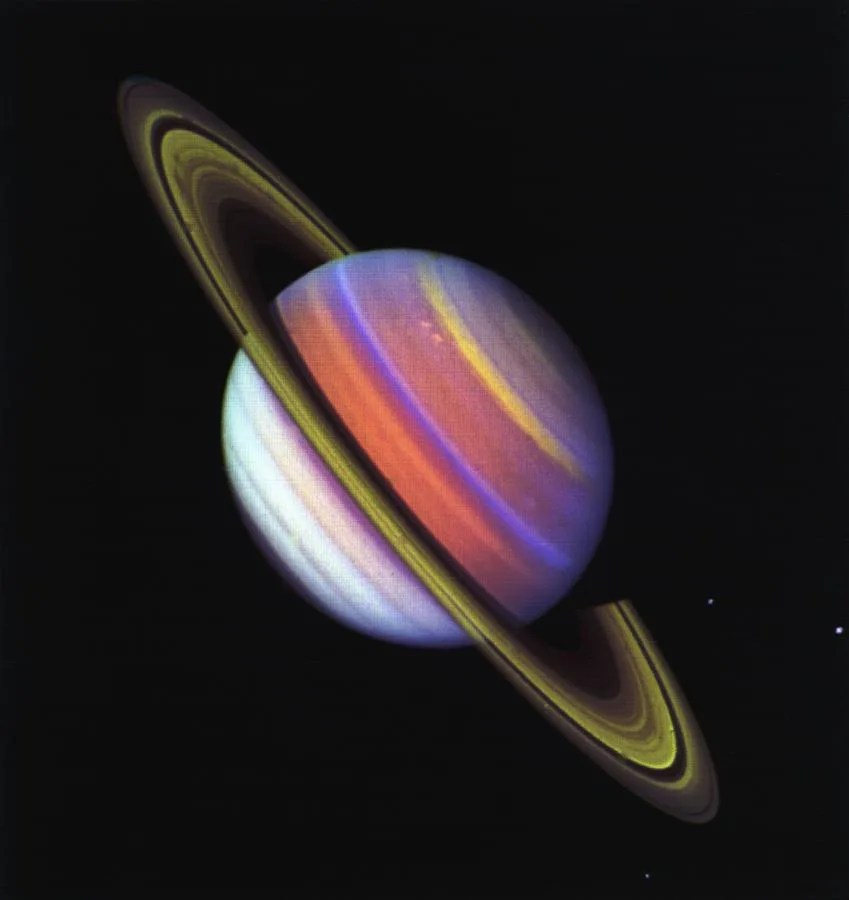
Following the Jupiter encounter, Voyager 1 completed an initial course correction on April 9, 1979 in preparation for its meeting with Saturn. A second correction on Oct. 10, 1979 ensured that the spacecraft would not hit Saturn’s moon Titan.
Its flyby of the Saturn system in November 1979 was as spectacular as its previous encounter. Voyager 1 found five new moons, a ring system consisting of thousands of bands, wedge-shaped transient clouds of tiny particles in the B ring that scientists called “spokes,” a new ring (the “G-ring”), and “shepherding” satellites on either side of the F-ring—satellites that keep the rings well-defined.
During its flyby, the spacecraft photographed Saturn’s moons Titan, Mimas, Enceladus, Tethys, Dione, and Rhea. Based on incoming data, all the moons appeared to be composed largely of water ice. Perhaps the most interesting target was Titan, which Voyager 1 passed at 05:41 UT on November 12 at a range of 2,500 miles (4,000 km). Images showed a thick atmosphere that completely hid the surface. The spacecraft found that the moon’s atmosphere was composed of 90% nitrogen. Pressure ad temperature at the surface was 1.6 atmospheres and 356 °F (–180°C), respectively.
Atmospheric data suggested that Titan might be the first body in the solar system (apart from Earth) where liquid might exist on the surface. In addition, the presence of nitrogen, methane, and more complex hydrocarbons indicated that prebiotic chemical reactions might be possible on Titan.
Voyager 1’s closest approach to Saturn was at 23:46 UT on 12 Nov. 12, 1980 at a range of 78,000 miles(126,000 km).
Voyager 1’s ‘Family Portrait’ Image
Following the encounter with Saturn, Voyager 1 headed on a trajectory escaping the solar system at a speed of about 3.5 AU per year, 35° out of the ecliptic plane to the north, in the general direction of the Sun’s motion relative to nearby stars. Because of the specific requirements for the Titan flyby, the spacecraft was not directed to Uranus and Neptune.
The final images taken by the Voyagers comprised a mosaic of 64 images taken by Voyager 1 on Feb. 14, 1990 at a distance of 40 AU of the Sun and all the planets of the solar system (although Mercury and Mars did not appear, the former because it was too close to the Sun and the latter because Mars was on the same side of the Sun as Voyager 1 so only its dark side faced the cameras).
This was the so-called “pale blue dot” image made famous by Cornell University professor and Voyager science team member Carl Sagan (1934-1996). These were the last of a total of 67,000 images taken by the two spacecraft.
Voyager 1’s Interstellar Mission
All the planetary encounters finally over in 1989, the missions of Voyager 1 and 2 were declared part of the Voyager Interstellar Mission (VIM), which officially began on Jan. 1, 1990.
The goal was to extend NASA’s exploration of the solar system beyond the neighborhood of the outer planets to the outer limits of the Sun’s sphere of influence, and “possibly beyond.” Specific goals include collecting data on the transition between the heliosphere, the region of space dominated by the Sun’s magnetic field and solar field, and the interstellar medium.
On Feb. 17, 1998, Voyager 1 became the most distant human-made object in existence when, at a distance of 69.4 AU from the Sun when it “overtook” Pioneer 10.
On Dec. 16, 2004, Voyager scientists announced that Voyager 1 had reported high values for the intensity for the magnetic field at a distance of 94 AU, indicating that it had reached the termination shock and had now entered the heliosheath.
The spacecraft finally exited the heliosphere and began measuring the interstellar environment on Aug. 25, 2012, the first spacecraft to do so.
On Sept. 5, 2017, NASA marked the 40th anniversary of its launch, as it continues to communicate with NASA’s Deep Space Network and send data back from four still-functioning instruments—the cosmic ray telescope, the low-energy charged particles experiment, the magnetometer, and the plasma waves experiment.
The Golden Record

Each of the Voyagers contain a “message,” prepared by a team headed by Carl Sagan, in the form of a 12-inch (30 cm) diameter gold-plated copper disc for potential extraterrestrials who might find the spacecraft. Like the plaques on Pioneers 10 and 11, the record has inscribed symbols to show the location of Earth relative to several pulsars.
The records also contain instructions to play them using a cartridge and a needle, much like a vinyl record player. The audio on the disc includes greetings in 55 languages, 35 sounds from life on Earth (such as whale songs, laughter, etc.), 90 minutes of generally Western music including everything from Mozart and Bach to Chuck Berry and Blind Willie Johnson. It also includes 115 images of life on Earth and recorded greetings from then U.S. President Jimmy Carter (1924– ) and then-UN Secretary-General Kurt Waldheim (1918–2007).
By January 2024, Voyager 1 was about 136 AU (15 billion miles, or 20 billion kilometers) from Earth, the farthest object created by humans, and moving at a velocity of about 38,000 mph (17.0 kilometers/second) relative to the Sun.

National Space Science Data Center: Voyager 1
A library of technical details and historic perspective.

Beyond Earth: A Chronicle of Deep Space Exploration
A comprehensive history of missions sent to explore beyond Earth.
Discover More Topics From NASA

Our Solar System


Voyages Inter-Missions
Agence de voyages spécialisée dans l’organisation de circuits culturels et de pèlerinages depuis plus de 30 ans. Par la découverte des plus beaux sanctuaires, chacun des voyages proposés est une invitation à vivre une expérience de ressourcement spirituel et humain.
Emplacement

Sanctuaire Diocésain Ste-Thérèse-de-l'Enfant-Jésus © I.Pécheux

Oratoire St-Joseph du Mont-Royal

Abbaye Val-Notre-Dame © I.Pécheux

Ermitage Saint-Antoine du Lac-Bouchette © Ermitage Saint-Antoine du Lac-Bouchette

Chapelle de Tadoussac © F.Pécheux

Thématiques
Vous pourriez aimer aussi.


Voyager 1 enters interstellar space in an illustration. The NASA spacecraft officially crossed into the space between the stars in 2012.
Both of NASA's Voyager spacecraft are now interstellar. Where to next?
Launched in 1977, the twin probes will likely outlive the sun. Find out what star systems they’ll meet as they head deeper into the galaxy.
NASA’s twin Voyager spacecraft have been traveling the interstellar road for more than 40 years, sweeping past the giant planets of the outer solar system before heading to the very fringes of our sun’s domain. Now, one probe has achieved a milestone in exploration: On December 10, NASA announced that Voyager 2 has entered interstellar space , six years after Voyager 1 first crossed the threshold. The twins are the only two spacecraft ever to venture so far from home.
To confirm Voyager 2's exit, scientists analyzed data from the spacecraft's Plasma Science Experiment , which measured the heliopause—the boundary between the sun's protective plasma bubble and interstellar space. On November 5, the instrument recorded a steep decline in particles from the sun's plasma. At the same time, Voyager 2 saw more high-energy particles from elsewhere in the galaxy, confirming that the probe had left our cosmic cul-de-sac.
"Working on Voyager makes me feel like an explorer, because everything we're seeing is new," MIT researcher John Richardson, the principal investigator for the plasma experiment, said in a statement . "Even though Voyager 1 crossed the heliopause in 2012, it did so at a different place and a different time, and without the PLS data. So we're still seeing things that no one has seen before."
But even at more than 11 billion miles from the sun, the Voyagers’ story is just beginning. On their current paths, both probes will still be heading outward across the galaxy eons after they escape the gravitational tug of the sun, and perhaps long after our star dies in four or five billion years. Should the spacecraft ever be intercepted by an alien civilization, two golden records bearing the sights and sounds of planet Earth could play the last whispers of a long-dead planet.
Assuming they stay on course, it’s going to be a lonely trip for the Voyagers, because even though our Earthly skies appear to glitter with countless pinpricks of light, space is mostly empty. Distances between the stars are so vast that even when our galaxy smashes into the one next door , not much will happen in the way of stellar collisions.
Still, according to astronomers’ predictions, their cosmic treks will bring the Voyagers close to several starry milestones and a dust cloud or three over the next hundred thousand or so years. Here are some of the known cosmic landmarks the Voyagers could meet in their relatively near futures.
For Hungry Minds
Launched from Cape Canaveral, Florida, on August 20, 1977, the dairy cow-size Voyager 2 began its odyssey with a grand tour of the outer solar system, making vital discoveries at Jupiter and Saturn and returning some of the best views yet of Uranus and Neptune.
The probe is now dipping below the plane of the solar system at roughly 34,500 miles an hour and heading celestially south, toward the constellation Sagittarius. On November 5, 2018, it crossed the heliopause, exiting the sun’s protective plasma bubble.
Voyager 2 may be freshly interstellar, but it won’t be anywhere near another star until 40,000 years from now, when it will pass within 1.7 light-years of the small red dwarf star Ross 248. At that point, Ross 248 will be the closest star to our sun, briefly eclipsing the Alpha Centauri system’s claim to fame as its path through the galaxy brings it just 3.02 light-years away.
About 61,000 years from now, Voyager 2 will pass beyond the Oort Cloud—a large, diffuse swarm of icy objects that is thought to extend as far as 200,000 times farther from the sun than Earth, says Wesleyan University’s Seth Redfield .
Voyager 2 may be freshly interstellar, but it won’t be anywhere near another star until 40,000 years from now.
Most scientists think the Oort cloud is the source of comets that take thousands of years to complete one orbit around the sun. It could also be the true boundary of the solar system, if you consider that to be the point where the sun’s gravitational influence drops off.
“The outer edge of the Oort Cloud is approximately where that is,” says Redfield, who has used the Hubble Space Telescope to study the Voyagers’ paths in detail for the next hundred thousand years, and more crudely for the next several million.
Next, in the year 298,000 Voyager 2 will swing within about four light-years of Sirius, the brightest star in Earth’s sky. It’ll then brush by two stars, delta Pav and GJ 754, about a hundred thousand years later.
Voyager 1 followed its twin into the sky on September 5, 1977. It rendezvoused with Jupiter and Saturn in 1979 and 1980, returning some spectacular views of volcanoes erupting on the Jovian moon Io, then continued outward.
You May Also Like

Why go back to the moon? NASA’s Artemis program has even bigger ambitions

'The sky is opening up': NASA's Webb Telescope captures jaw-dropping views of the cosmos

Why NASA's high-stakes maneuver to redirect an asteroid surprised its own scientists
On February 14, 1990, it swiveled to capture the solar system retreating from its view, including a series of images that revealed our pale blue planet looking like “a mote of dust suspended in a sunbeam,” according to Carl Sagan.
Now traveling more than 35,000 miles an hour in the direction of the constellation Ophiuchus, Voyager 1 is the fastest human-made object in space. In 2013, it became the first spacecraft to leave the heliosphere and cross into interstellar space.
In the year 40,272, the spacecraft will sail within 1.7 light-years of the star Gliese 445 in the constellation Camelopardalis.
In 56,000 years, Voyager 1 will exit the Oort cloud, then brush by the stars GJ 686 and GJ 678 in 570,000 years.
Wandering Wonders
Beyond that, both spacecraft will continue on their journeys outward, passing through scattered dust clouds on their way through the local bubble, a cavern of relatively empty space blown by tempestuous dying stars. They’ll exit this bubble in 5.7 and 6.3 million years, respectively.
From there, things get murky. The peculiar motions of stars and dust clouds orbiting the galactic center aren’t well known yet, and the spacecraft could be slowed by sailing through dust clouds. Plus, gravitational encounters with things like wandering, starless planets could bounce the probes around like billiard balls.
“There may be a whole population of rogue planets out in interstellar space,” Redfield says. “A mildly close encounter with one of those could change the itinerary of the Voyagers.”
Ultimately, like the stars in the Milky Way, the Voyagers will march to the galaxy’s tune and orbit its core for the rest of their lives.
“All the stars in the solar neighborhood are in an orbit around the center of the Milky Way, with orbital periods of 225 to 250 million years,” says Voyager project scientist Ed Stone . “The Voyagers will also be in such independent orbits, completing an orbit every 225 million years for billions of years until a collision with another galaxy disrupts this orderly flow.”
That might occur in four billion years, when the neighboring Andromeda galaxy smashes into the Milky Way and rearranges our skies in spectacular ways.
How the Voyagers’ ultimate demise occurs—whether it’s death by a thousand micrometeorite impacts, or one large improbable collision—remains a mystery. It’s even possible the Voyagers will outlive the solar system, surviving long after the sun’s death sculpts our neighborhood into a dramatically different place.
“The universe tends to do a great job of preserving its occupants,” Redfield says. After all, “the objects in our solar system, even small objects, have been around for 4.5 billion years.”
Related Topics

Why NASA’s Interstellar Mission Almost Didn’t Happen

U.S. returns to the moon as NASA's Odysseus successfully touches down

What is causing these massive, mysterious explosions in space?

The world’s most powerful telescope is rewriting the story of space and time
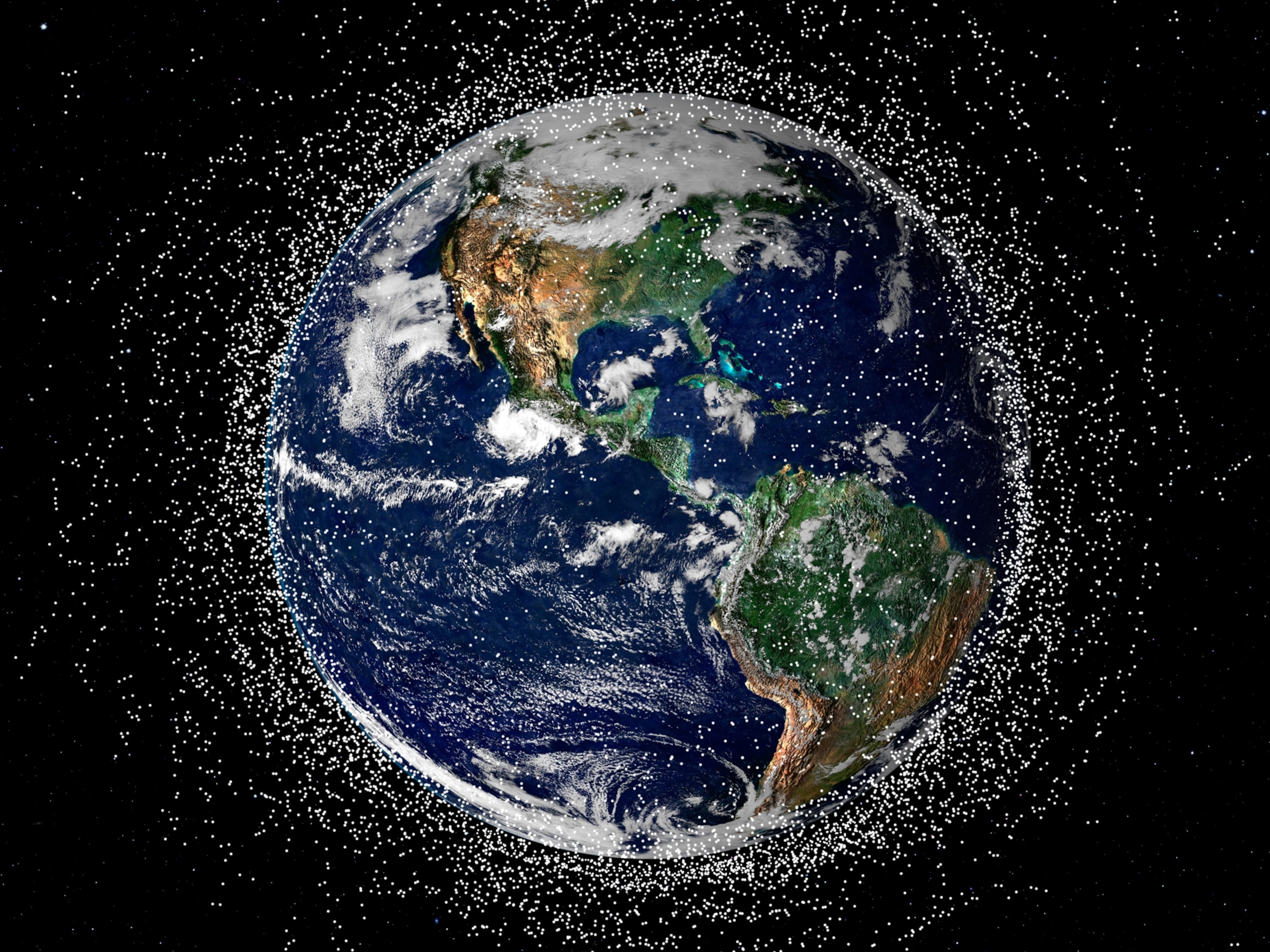
NASA has a plan to clean up space junk—but is going green enough?
- Environment
History & Culture
- History & Culture
- History Magazine
- Mind, Body, Wonder
- Coronavirus Coverage
- Paid Content
- Terms of Use
- Privacy Policy
- Your US State Privacy Rights
- Children's Online Privacy Policy
- Interest-Based Ads
- About Nielsen Measurement
- Do Not Sell or Share My Personal Information
- Nat Geo Home
- Attend a Live Event
- Book a Trip
- Inspire Your Kids
- Shop Nat Geo
- Visit the D.C. Museum
- Learn About Our Impact
- Support Our Mission
- Advertise With Us
- Customer Service
- Renew Subscription
- Manage Your Subscription
- Work at Nat Geo
- Sign Up for Our Newsletters
- Contribute to Protect the Planet
Copyright © 1996-2015 National Geographic Society Copyright © 2015-2024 National Geographic Partners, LLC. All rights reserved
Inside NASA's 5-month fight to save the Voyager 1 mission in interstellar space

After working for five months to re-establish communication with the farthest-flung human-made object in existence, NASA announced this week that the Voyager 1 probe had finally phoned home.
For the engineers and scientists who work on NASA’s longest-operating mission in space, it was a moment of joy and intense relief.
“That Saturday morning, we all came in, we’re sitting around boxes of doughnuts and waiting for the data to come back from Voyager,” said Linda Spilker, the project scientist for the Voyager 1 mission at NASA’s Jet Propulsion Laboratory in Pasadena, California. “We knew exactly what time it was going to happen, and it got really quiet and everybody just sat there and they’re looking at the screen.”
When at long last the spacecraft returned the agency’s call, Spilker said the room erupted in celebration.
“There were cheers, people raising their hands,” she said. “And a sense of relief, too — that OK, after all this hard work and going from barely being able to have a signal coming from Voyager to being in communication again, that was a tremendous relief and a great feeling.”

The problem with Voyager 1 was first detected in November . At the time, NASA said it was still in contact with the spacecraft and could see that it was receiving signals from Earth. But what was being relayed back to mission controllers — including science data and information about the health of the probe and its various systems — was garbled and unreadable.
That kicked off a monthslong push to identify what had gone wrong and try to save the Voyager 1 mission.
Spilker said she and her colleagues stayed hopeful and optimistic, but the team faced enormous challenges. For one, engineers were trying to troubleshoot a spacecraft traveling in interstellar space , more than 15 billion miles away — the ultimate long-distance call.
“With Voyager 1, it takes 22 1/2 hours to get the signal up and 22 1/2 hours to get the signal back, so we’d get the commands ready, send them up, and then like two days later, you’d get the answer if it had worked or not,” Spilker said.

The team eventually determined that the issue stemmed from one of the spacecraft’s three onboard computers. Spilker said a hardware failure, perhaps as a result of age or because it was hit by radiation, likely messed up a small section of code in the memory of the computer. The glitch meant Voyager 1 was unable to send coherent updates about its health and science observations.
NASA engineers determined that they would not be able to repair the chip where the mangled software is stored. And the bad code was also too large for Voyager 1's computer to store both it and any newly uploaded instructions. Because the technology aboard Voyager 1 dates back to the 1960s and 1970s, the computer’s memory pales in comparison to any modern smartphone. Spilker said it’s roughly equivalent to the amount of memory in an electronic car key.
The team found a workaround, however: They could divide up the code into smaller parts and store them in different areas of the computer’s memory. Then, they could reprogram the section that needed fixing while ensuring that the entire system still worked cohesively.
That was a feat, because the longevity of the Voyager mission means there are no working test beds or simulators here on Earth to test the new bits of code before they are sent to the spacecraft.
“There were three different people looking through line by line of the patch of the code we were going to send up, looking for anything that they had missed,” Spilker said. “And so it was sort of an eyes-only check of the software that we sent up.”
The hard work paid off.
NASA reported the happy development Monday, writing in a post on X : “Sounding a little more like yourself, #Voyager1.” The spacecraft’s own social media account responded , saying, “Hi, it’s me.”
So far, the team has determined that Voyager 1 is healthy and operating normally. Spilker said the probe’s scientific instruments are on and appear to be working, but it will take some time for Voyager 1 to resume sending back science data.
Voyager 1 and its twin, the Voyager 2 probe, each launched in 1977 on missions to study the outer solar system. As it sped through the cosmos, Voyager 1 flew by Jupiter and Saturn, studying the planets’ moons up close and snapping images along the way.
Voyager 2, which is 12.6 billion miles away, had close encounters with Jupiter, Saturn, Uranus and Neptune and continues to operate as normal.
In 2012, Voyager 1 ventured beyond the solar system , becoming the first human-made object to enter interstellar space, or the space between stars. Voyager 2 followed suit in 2018.
Spilker, who first began working on the Voyager missions when she graduated college in 1977, said the missions could last into the 2030s. Eventually, though, the probes will run out of power or their components will simply be too old to continue operating.
Spilker said it will be tough to finally close out the missions someday, but Voyager 1 and 2 will live on as “our silent ambassadors.”
Both probes carry time capsules with them — messages on gold-plated copper disks that are collectively known as The Golden Record . The disks contain images and sounds that represent life on Earth and humanity’s culture, including snippets of music, animal sounds, laughter and recorded greetings in different languages. The idea is for the probes to carry the messages until they are possibly found by spacefarers in the distant future.
“Maybe in 40,000 years or so, they will be getting relatively close to another star,” Spilker said, “and they could be found at that point.”
Denise Chow is a reporter for NBC News Science focused on general science and climate change.
- Share full article
Advertisement
Supported by
Voyager 1, First Craft in Interstellar Space, May Have Gone Dark
The 46-year-old probe, which flew by Jupiter and Saturn in its youth and inspired earthlings with images of the planet as a “Pale Blue Dot,” hasn’t sent usable data from interstellar space in months.

By Orlando Mayorquin
When Voyager 1 launched in 1977, scientists hoped it could do what it was built to do and take up-close images of Jupiter and Saturn. It did that — and much more.
Voyager 1 discovered active volcanoes, moons and planetary rings, proving along the way that Earth and all of humanity could be squished into a single pixel in a photograph, a “ pale blue dot, ” as the astronomer Carl Sagan called it. It stretched a four-year mission into the present day, embarking on the deepest journey ever into space.
Now, it may have bid its final farewell to that faraway dot.
Voyager 1 , the farthest man-made object in space, hasn’t sent coherent data to Earth since November. NASA has been trying to diagnose what the Voyager mission’s project manager, Suzanne Dodd, called the “most serious issue” the robotic probe has faced since she took the job in 2010.
The spacecraft encountered a glitch in one of its computers that has eliminated its ability to send engineering and science data back to Earth.
The loss of Voyager 1 would cap decades of scientific breakthroughs and signal the beginning of the end for a mission that has given shape to humanity’s most distant ambition and inspired generations to look to the skies.
“Scientifically, it’s a big loss,” Ms. Dodd said. “I think — emotionally — it’s maybe even a bigger loss.”
Voyager 1 is one half of the Voyager mission. It has a twin spacecraft, Voyager 2.
Launched in 1977, they were primarily built for a four-year trip to Jupiter and Saturn , expanding on earlier flybys by the Pioneer 10 and 11 probes.
The Voyager mission capitalized on a rare alignment of the outer planets — once every 175 years — allowing the probes to visit all four.
Using the gravity of each planet, the Voyager spacecraft could swing onto the next, according to NASA .
The mission to Jupiter and Saturn was a success.
The 1980s flybys yielded several new discoveries, including new insights about the so-called great red spot on Jupiter, the rings around Saturn and the many moons of each planet.
Voyager 2 also explored Uranus and Neptune , becoming in 1989 the only spacecraft to explore all four outer planets.

Voyager 1, meanwhile, had set a course for deep space, using its camera to photograph the planets it was leaving behind along the way. Voyager 2 would later begin its own trek into deep space.
“Anybody who is interested in space is interested in the things Voyager discovered about the outer planets and their moons,” said Kate Howells, the public education specialist at the Planetary Society, an organization co-founded by Dr. Sagan to promote space exploration.
“But I think the pale blue dot was one of those things that was sort of more poetic and touching,” she added.
On Valentine’s Day 1990, Voyager 1, darting 3.7 billion miles away from the sun toward the outer reaches of the solar system, turned around and snapped a photo of Earth that Dr. Sagan and others understood to be a humbling self-portrait of humanity.
“It’s known the world over, and it does connect humanity to the stars,” Ms. Dodd said of the mission.
She added: “I’ve had many, many many people come up to me and say: ‘Wow, I love Voyager. It’s what got me excited about space. It’s what got me thinking about our place here on Earth and what that means.’”
Ms. Howells, 35, counts herself among those people.
About 10 years ago, to celebrate the beginning of her space career, Ms. Howells spent her first paycheck from the Planetary Society to get a Voyager tattoo.
Though spacecraft “all kind of look the same,” she said, more people recognize the tattoo than she anticipated.
“I think that speaks to how famous Voyager is,” she said.
The Voyagers made their mark on popular culture , inspiring a highly intelligent “Voyager 6” in “Star Trek: The Motion Picture” and references on “The X Files” and “The West Wing.”
Even as more advanced probes were launched from Earth, Voyager 1 continued to reliably enrich our understanding of space.
In 2012, it became the first man-made object to exit the heliosphere, the space around the solar system directly influenced by the sun. There is a technical debate among scientists around whether Voyager 1 has actually left the solar system, but, nonetheless, it became interstellar — traversing the space between stars.
That charted a new path for heliophysics, which looks at how the sun influences the space around it. In 2018, Voyager 2 followed its twin between the stars.
Before Voyager 1, scientific data on the sun’s gases and material came only from within the heliosphere’s confines, according to Dr. Jamie Rankin, Voyager’s deputy project scientist.
“And so now we can for the first time kind of connect the inside-out view from the outside-in,” Dr. Rankin said, “That’s a big part of it,” she added. “But the other half is simply that a lot of this material can’t be measured any other way than sending a spacecraft out there.”
Voyager 1 and 2 are the only such spacecraft. Before it went offline, Voyager 1 had been studying an anomalous disturbance in the magnetic field and plasma particles in interstellar space.
“Nothing else is getting launched to go out there,” Ms. Dodd said. “So that’s why we’re spending the time and being careful about trying to recover this spacecraft — because the science is so valuable.”
But recovery means getting under the hood of an aging spacecraft more than 15 billion miles away, equipped with the technology of yesteryear. It takes 45 hours to exchange information with the craft.
It has been repeated over the years that a smartphone has hundreds of thousands of times Voyager 1’s memory — and that the radio transmitter emits as many watts as a refrigerator lightbulb.
“There was one analogy given that is it’s like trying to figure out where your cursor is on your laptop screen when your laptop screen doesn’t work,” Ms. Dodd said.
Her team is still holding out hope, she said, especially as the tantalizing 50th launch anniversary in 2027 approaches. Voyager 1 has survived glitches before, though none as serious.
Voyager 2 is still operational, but aging. It has faced its own technical difficulties too.
NASA had already estimated that the nuclear-powered generators of both spacecrafts would likely die around 2025.
Even if the Voyager interstellar mission is near its end, the voyage still has far to go.
Voyager 1 and its twin, each 40,000 years away from the next closest star, will arguably remain on an indefinite mission.
“If Voyager should sometime in its distant future encounter beings from some other civilization in space, it bears a message,” Dr. Sagan said in a 1980 interview .
Each spacecraft carries a gold-plated phonograph record loaded with an array of sound recordings and images representing humanity’s richness, its diverse cultures and life on Earth.
“A gift across the cosmic ocean from one island of civilization to another,” Dr. Sagan said.
Orlando Mayorquin is a general assignment and breaking news reporter based in New York. More about Orlando Mayorquin
What’s Up in Space and Astronomy
Keep track of things going on in our solar system and all around the universe..
Never miss an eclipse, a meteor shower, a rocket launch or any other 2024 event that’s out of this world with our space and astronomy calendar .
A celestial image, an Impressionistic swirl of color in the center of the Milky Way, represents a first step toward understanding the role of magnetic fields in the cycle of stellar death and rebirth.
Scientists may have discovered a major flaw in their understanding of dark energy, a mysterious cosmic force . That could be good news for the fate of the universe.
A new set of computer simulations, which take into account the effects of stars moving past our solar system, has effectively made it harder to predict Earth’s future and reconstruct its past.
Dante Lauretta, the planetary scientist who led the OSIRIS-REx mission to retrieve a handful of space dust , discusses his next final frontier.
Is Pluto a planet? And what is a planet, anyway? Test your knowledge here .
Pioneer and Voyager Missions

For three decades, Pioneers 10 and 11 traveled through space, achieving a series of firsts in space exploration. Launched in 1972, Pioneer 10 became the first man-made object to pass through the asteroid belt between Mars and Jupiter, to fly by Jupiter, and to subsequently leave the solar system. Pioneer 11, launched the next year, followed Pioneer 10 past Jupiter and became the first space probe to observe Saturn. Both spacecraft carried plaques depicting male and female representatives of the human race and provided information about our location in the solar system.
Pioneer 10 was not the first space probe to capture and return images from space, but the technology it used to do so was typical of such missions. The famous images of Jupiter that the craft sent to earth were taken with a special device called an imaging photopolarimeter. Along with special electronic circuits, this device collected incoming light from the planet, digitized it, and sent it by microwave radio transmission back to earth at a speed of about 1024 bits per second. This is on the slow side, but the slow speed helps ensure few errors. Because Pioneer was designed to spin as it flew, it captured an image of the planet in small bits that were transmitted and reassembled into a complete picture back on earth.
Pioneer’s transmitter operated at a frequency of 2.5 GHz, close to that of a microwave oven. With an output power of only 8 Watts however, this transmitter consumed much less power than a microwave, and only slightly more than the electric clock on the nightstand. In fact, the power system of the entire satellite could just about light up a 150 Watt incandescent bulb.
The Pioneers were nuclear-powered because sunlight is too weak beyond Jupiter to have provided energy with solar arrays. By 1995, Pioneer 11’s nuclear power source was nearly spent; with the probe unable to collect or transmit data, NASA ended the Pioneer 11 mission. Pioneer 10, however, continued to astonish scientists by transmitting and receiving communications some 7.5 billion miles away. Although NASA formally decommissioned the spacecraft in 1997, scientists sent greetings to Pioneer 10 on its 30th birthday, 2 March 2002. After a little more than 22 hours, the time it took for the signal to travel out and return at the speed of light, Pioneer 10 answered back. Pioneer 10 is heading toward the constellation Taurus, but won’t reach Aldebaran, the nearest star there, for 2 million years. In January of 2003, NASA received what became the last, faint signal from Pioneer 10; they officially ended the project the following month.
Pioneers 10 and 11 served as pathfinders for the Voyager 1 and 2 spacecrafts, which were launched 16 days apart in 1973. Along with instrumentation for scientific measurements, each probe carried a phonograph disc containing sounds and images representing human experience and achievement. The original Voyager mission was a five-year exploration of Jupiter and Saturn, Saturn’s rings, and the larger moons of the two planets. The mission was expanded to include flybys of Uranus and Neptune. Voyager discoveries include the fast winds of Neptune, kinks in Saturn’s rings, and volcanoes on Jupiter’s moon, Io. The Voyager mission was timed to take advantage of a planetary configuration that occurs about once every 175 years and allows a spacecraft to fly by Jupiter, Saturn, Uranus, and Neptune without requiring large propulsion systems.
After 25 years in space, the probes are still going strong, studying the heliopause—the boundary between the solar wind and interstellar gas. Voyager 1 is now the most distant man-made object in the universe, nearly 8 billion miles from Earth, while Voyager 2 is about 6 billion miles away.
- Communications
- Communication equipment
- Transmitters
- Radio astronomy
- Aerospace engineering

May 13, 2024 | 7PM

An Evening of Queer Theater to benefit New Alternatives for Homeless LGBT Youth
Hosted by peppermint.
Premiere short plays by: Fernanda Coppel , Mashuq Mushtaq Deen , Ty Defoe , Marquis D. Gibson , Nina Ki , Derick Edgren Otero , Harrison David Rivers , J. Harvey Stone , Lucy Thurber , Doug Wright

“On the scrappy Off-Off-Broadway end of the NYC spectrum, Voyage Theater Company has been in business for a decade…producing plays in translation alongside U.S. plays that focus on immigrant communities.”
AMERICAN THEATRE, July 20 2023


IMAGES
COMMENTS
The mission objective of the Voyager Interstellar Mission (VIM) is to extend the NASA exploration of the solar system beyond the neighborhood of the outer planets to the outer limits of the Sun's sphere of influence, and possibly beyond. This extended mission is continuing to characterize the outer solar system environment and search for the ...
Mission Overview. The twin Voyager 1 and 2 spacecraft are exploring where nothing from Earth has flown before. Continuing on their more-than-40-year journey since their 1977 launches, they each are much farther away from Earth and the sun than Pluto. In August 2012, Voyager 1 made the historic entry into interstellar space, the region between ...
Voyages Inter- Missions, Montreal, QC. Voyages Inter-Missions est une référence dans l'organisation de pèlerinages et d'itinéraires spirituels et culturels.
The Voyage to Interstellar Space. By all means, Voyager 1 and Voyager 2 shouldn't even be here. Now in interstellar space, they are pushing the limits of spacecraft and exploration, journeying through the cosmic neighborhood, giving us our first direct look into the space beyond our star. But when they launched in 1977, Voyager 1 and Voyager ...
A poster of the planets and moons visited during the Voyager program. The Voyager program is an American scientific program that employs two interstellar probes, Voyager 1 and Voyager 2.They were launched in 1977 to take advantage of a favorable alignment of the two gas giants Jupiter and Saturn and the ice giants, Uranus and Neptune, to fly near them while collecting data for transmission ...
What. Voyager 1 and its twin Voyager 2 are the only spacecraft ever to operate outside the heliosphere, the protective bubble of particles and magnetic fields generated by the Sun. Voyager 1 reached the interstellar boundary in 2012, while Voyager 2 (traveling slower and in a different direction than its twin) reached it in 2018.
About the mission. Voyager 1 reached interstellar space in August 2012 and is the most distant human-made object in existence. Launched just shortly after its twin spacecraft, Voyager 2, in 1977, Voyager 1 explored the Jovian and Saturnian systems discovering new moons, active volcanoes and a wealth of data about the outer solar system.
The late popular astronomer Carl Sagan, who wrote those words about the now iconic "Pale Blue Dot" photo (below) would today surely be working on the "Interstellar Probe," a new mission ...
What are the Voyager missions? The Voyager program consists of two spacecraft: Voyager 1 and Voyager 2. Voyager 2 was actually launched first, in August 1977, but Voyager 1 was sent on a faster trajectory when it launched about two weeks later. They are the only two functioning spacecraft currently in interstellar space, beyond the environment ...
Voyager 1 has been exploring our solar system for more than 45 years. The probe is now in interstellar space, the region outside the heliopause, or the bubble of energetic particles and magnetic fields from the Sun. Voyager 1 is the first human-made object to venture into interstellar space. Voyager 1 discovered a thin ring around Jupiter and ...
Voyages Inter-Missions. Agence de voyages spécialisée dans l'organisation de circuits culturels et de pèlerinages depuis plus de 30 ans. Par la découverte des plus beaux sanctuaires, chacun des voyages proposés est une invitation à vivre une expérience de ressourcement spirituel et humain. Visiter le site internet.
About 61,000 years from now, Voyager 2 will pass beyond the Oort Cloud—a large, diffuse swarm of icy objects that is thought to extend as far as 200,000 times farther from the sun than Earth ...
Inside NASA's 5-month fight to save the Voyager 1 mission in interstellar space. The Voyager 1 probe is the most distant human-made object in existence. After a major effort to restore ...
Even if the Voyager interstellar mission is near its end, the voyage still has far to go. Voyager 1 and its twin, each 40,000 years away from the next closest star, will arguably remain on an ...
Find company research, competitor information, contact details & financial data for Voyages Inter-Missions Inc of Montréal, QC. Get the latest business insights from Dun & Bradstreet.
Pioneers 10 and 11 served as pathfinders for the Voyager 1 and 2 spacecrafts, which were launched 16 days apart in 1973. Along with instrumentation for scientific measurements, each probe carried a phonograph disc containing sounds and images representing human experience and achievement. The original Voyager mission was a five-year exploration ...
Premiere short plays by: Fernanda Coppel, Mashuq Mushtaq Deen, Ty Defoe, Marquis D. Gibson, Nina Ki, Derick Edgren Otero, Harrison David Rivers, J. Harvey Stone, Lucy Thurber, Doug Wright. TICKETS. "On the scrappy Off-Off-Broadway end of the NYC spectrum, Voyage Theater Company has been in business for a decade…producing plays in ...
This organization is not BBB accredited. Travel Agency in Montréal, QC. See BBB rating, reviews, complaints, & more.
The Moscow International Business Center (MIBC), also known as Moscow-City, is a commercial development in Moscow, the capital of Russia.The project occupies an area of 60 hectares, and is located just east of the Third Ring Road at the western edge of the Presnensky District in the Central Administrative Okrug.Construction of the MIBC takes place on the Presnenskaya Embankment of the Moskva ...
Crocus City Hall attack. / 55.82583°N 37.39028°E / 55.82583; 37.39028. On 22 March 2024, a terrorist attack which was carried out by the Islamic State (IS) occurred at the Crocus City Hall music venue in Krasnogorsk, Moscow Oblast, Russia. The attack began at around 20:00 MSK ( UTC+3 ), shortly before the Russian band Picnic was ...
Provided to YouTube by IIP-DDSFirst Inter Galactic Trans-Mission Voyage · Anand KhareFirst Inter Galactic Trans-Mission Voyage℗ Anand KhareReleased on: 2024-...
Заказать Видео Поздравления 📲WhatsApp +79771330907Концерты и Реклама Карина📲WhatsApp ...
Moskau Hauptstadt Russlands 12 Millionen Einwohner. Stadtrundfahrt - Kreml - Roter Platz - GUM Kaufhaus - Metro größte U Bahn der Welt